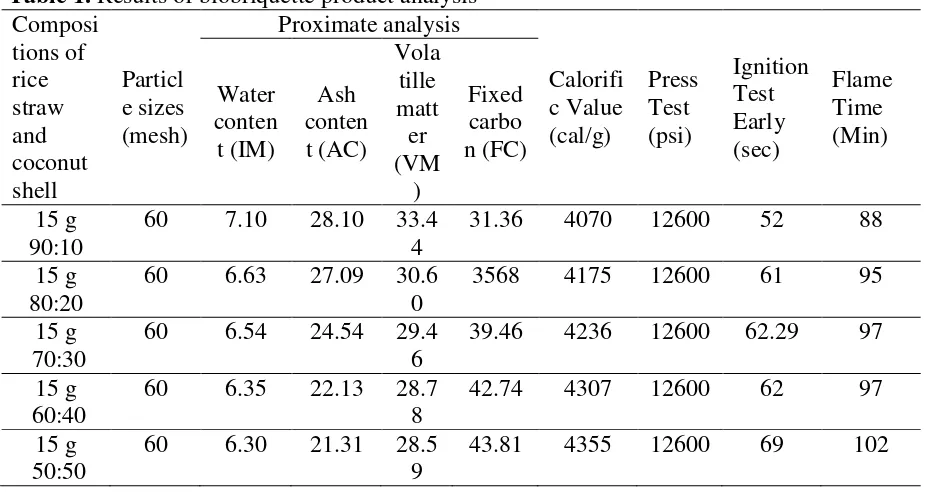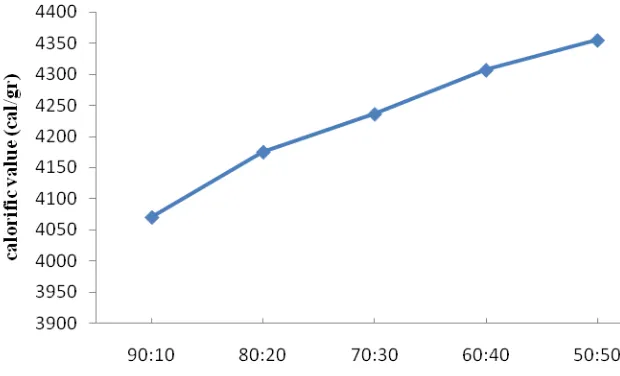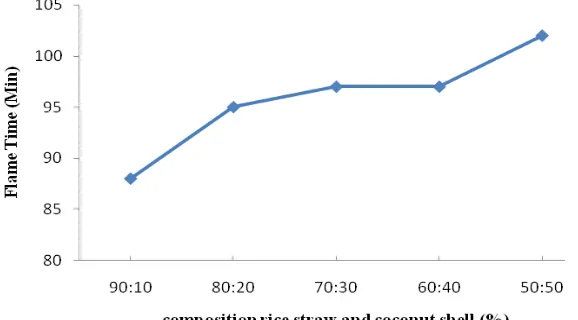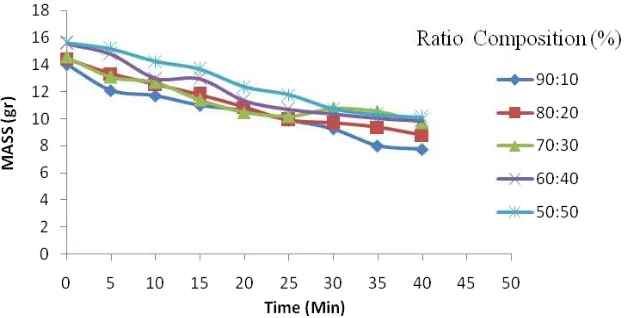253
Composition Variation Effect of Rice Straw and Coconut Shell to
Biobriquette Characteristics as Alternative Fuel
Muhammad Yerizam*1, Muhammad Faizal*2, Marsi*3, Novia*2
1
Doctoral Candidate of Enviromental Science, Sriwijaya University Chemical Engineering Depertement of State Polytechnic of sriwijaya, Jl. Srijaya Negara. Bukit Besar, Palembang 30139, Indonesia
2
Departement of Chemical, Engineering Faculty, Sriwijaya University, Indralaya 30662
3
Departement of Agriculture, Agriculture Faculty, Sriwijaya University, Indralaya 30662 Corresponding author: [email protected], [email protected], [email protected], [email protected]
Abstract
Rice straws are agricultural waste that have not been used by the public or farmers, they are considered as waste that no economic value, whereas rice straws have a big potential when processed into solid fuel, due to the rice straws have high content of volatile matter level so flammable, therefore rice straws used as raw materials in the manufacture of biobriquette. Biobriquette making process done by varying between rice straw and coconut due to coconut shell already has good essential in making biobriquette. Rice straw and coconut shell carbonated and then performed size reduction to 60 mesh size. Raw material analysis was conducted on moisture content, ash content, volatile matter, sulfur content, and calorific value. . The mixing charcoal and coconut rice straw with powder adhesive tapiuoka were doing with the composition of 90:10, 80:20, 70:30, 60:40, 50:50. After the mixing, the products scored. Further that the analysis of products included ultimate analysis, test press, calorific value, ignition test early, the flame time of biobriquettes, and the rate of mass reduction during combustion with the best results were obtained the biobioquette variation in the composition of 50:50 with 4355 cal / gr of calorific value, 69 seconds of beginning old flame and 102 minutes of ash briquette.
Key words: rice straw, coconut shell, biobriquettes, carbonization.
Introduction
The issue of rising oil price (especially kerosene) and LPG alerted us that energy consumption was increasing from year to year and it was not balanced with the availability of the energy sources. Scarcity and rising oil prices will continue to take place because it is non-renewable. This has to be balanced with the provision of energy sources. Renewable alternatives, the raw material is easy to find and cheap so affordable by the community. [3]. Agricultural waste such as rice straw has not been assessed as products that has economic value by farmers, even regarded as wastes that interfere with tillage and planting rice, so they let the straws were taken by someone else or burn it in place. Similarly with coconut shell, farmers only used the most part of coconuts into copra and shell allowed to become solid waste. Therefore wastes originating farms and plantations can be used as a solid fuel.
254
Subroto [9] made biobriquette of straw and wood charcoal with a ratio of 40%: 60%. Their research suggested that reduced levels of CO and high fuel value of 5.4 x10-3 kw. Supriyadi et al [11] produced biobriquette by utilizing agricultural waste feedstock mixed with coal 60%: 40%, where the results of their study showed the temperature 300oC with a time of 90 minutes gave the minimum CO levels. Mahendra [5] mixed Straw-coal to get fuel (biobriquette), with variation of raw materials. From the results of research that were 30% coal and 70% straw with a firing rate 3.5 g / min obtained at 890 ppm CO levels. Coconut shell is also a solid waste plantation his most farmers utilized as coconut shell charcoals. Ndraha [7] conducted a study biobriquette manufacture of coconut shell with wood dust. From the research obtained water content 4.74%, ash content of 5.61% and a calorific value of 7192.15 cal / g.
From the description above, the researcher conducted a study to utilize rice straw and coconut shell. In this case it is expected that waste rice straw and coconut shell can be used as biobriquette charcoal mixed with variation of raw material composition of 90% -50% rice straw and 10% -50% coconut shell using tapioca as an adhesive and press constancy 12600 Psi, which can be used as an alternative fuel.
Variables determined the quality biobriquette were volatile matter content, water content, ash and fixed carbon. The fuel value to be derived from the results of this study.
Materials and Methods
Procedure
Rice straw and coconut shell carbonization process is carried out at 298oC for rice straw within 24 minutes and 485 ° C for coconut shell within 15 minutes. Carbonization results for size 60 meshes sieve. Biobriquettes were produced by comparisons (Rice Straw: Coconut shell) 50%: 50%, 60%: 40%, 70%: 30%, 80%: 20% and 90%: 10% and mixed with 10% starch adhesive.Then they molded by using mold briquette with the cylinder size were 7.9 cm high, 2.54 cm ID, OD 4.5-in. Biobriquette dried in the oven at 110oC for a day and then they were analyzed water content by using the method of ASTM D.3173-03, analysis of ash content by using the method of ASTM D.3174-04, analysis of volatile matter content by using the ISO -562, fixed carbon analysis by using method ASTM D.3172-89, test press, calorific value by using ASTM D.5865-07, the old flame biobriquette to ashes and the rate of mass reduction during combustion.
Results and Discussion
255
Table 1. Results of biobriquette product analysis Composi
Table 2. Comparison mass reduction rate during combustion
Time the longest ignition early test.
Effect of Composition Ratio Variations to Calorific Value
256
Figure 1. Effect of composition ratio variation to calorific value
Figure 1 shows the calorific value graph of each briquettes produced which the variation of composition 50:50 (rice straw: coconut shell) had highest calorific value 4354.5 and the composition of 90:10 (rice straw: coconut shell) had low calorific value of 4070. It happened because the coconut shell had a higher calorific value than rice straw so that the larger the ratio the greater the coconut shell on the calorific value of briquettes produced.
Effect of Composition Ratio Variations of Rice Straw and Coconut Shell to Ignition Test Early
In Figure 2 below is effect of the composition ratio graph of rice straw and coconut shell where the comparison starts from 90:10 (rice straw and coconut shell) and until the ratio of 50:50 to ignition test early of briquettes produced.
Figure 2. Effect of composition ratio variation of rice straw and coconut shell to briquettes ignition test early.
257
a high content of volatile matter so combustible, combustion process occurred very quickly and relatively short baking time. So more straw rice composition will make ignition test early become faster.
Effect of The Composition Ratio of Rice Straw and Coconut Shell to Briquette Flame Time
In Figure 3, below is a composition ratio graph of rice straw and coconut shells which were used starting composition ratio of 90:10 (rice straw and coconut shell) until 50:50 to briquettes produced flame time.
Figure 3. Effect of composition ratio of rice straw and coconut shell to briquette flame time
Effect of coconut shell ratio and rice straw ratio to flame time can be seen in Figure 3 where the composition 90:10 (rice straw: coconut shell) was the fastest time while the composition of the longest flame time was 50:50, it was due to the rice straw physical properties with high content of volatile matter so combustible, combustion process occured very quickly and the burning time was relatively short. So it influenced briquette flame time, more straw rice composition will make short flame time
Effect of Rice Straw and Coconut Shell Composition Ratio to the Mass Reduction Rate During Combustion
258
Figure 4. Graph of mass reduction rate during combustion of biobriquette variety compositions
From Figure 4 can be seen how mass reduction rate of rice straw and coconut shell composition from 90:10, 80:20, 70:30, 60:40, 50:50. The composition of 90:10 (rice straw and coconut shell) has easy to flame and the fastest of flame time. Likewise mass reduction rate seen in the data this composition had fastest mass reduction rate compared with others, otherwise the composition ratio of 50:50 (rice straw and coconut shell) which had slow mass reduction rate. It was because the characteristic of the raw material had a high content of volatile matter so combustible, combustion process occurred very quickly and relatively short burning time. So it influenced briquette flame time, and mass reduction rate.
Conclusions
Based on the results obtained from this study several conclusions can be drawn as follows: 1. Biobriquette optimum conditions resulting in the composition ratio of 50:50 (rice straw and
coconut shell), with a calorific value of 4355 cal / g, total carbon 43.81%, 28.59% volatile matter content, water content 6.30 %, 12600 psi compressive strength, with ignition test early of 69 seconds, and the 102-minute flame time.
2. At 90:10 biobriquette composition (rice straw and coconut shell) had a rapid reduction mass rate compared to the others. It due to high content of volatile matter in the straw so combustible, combustion process occurred very quickly and relatively short burning time. It influenced briquette flame time, and mass reduction rate.
Acknowledgements
I thank the promoters and co-promoters who provide direction and guidance during the research and also the director of the state polytechnic Sriwijaya who have given financial support in this study and the completion of this seminar
References
[1] Aladin, Hadi dan Mahfud. (2011). Sumber Daya Alam Batubara. Cetakan I. Penerbit Lubuk Agung Bandung. ISBN: 978-979-505-230-2.
259
[3] Hall, D.O and R.P Overend.(1987). Biomass Regenerable Energy. John Wiley and Sons Ltd: Great Britain
[4] Kirk, R.E and D.F.Othmer. (1979). Encyclopedia of Chemical Technology. Third Edition. Vol. 6. John Wiley & Sons. Inc. New York. p.224-285. 307-323.
[5] Mahendra.H.S. (2010). Uji Karakteristik Pembakaran Briket Biomasa Jerami-Batubara dengan Variasi Komposisi. Laporan Akhir Pada Jurusan Teknik Mesin Fakultas Teknik Universitas Muhammadyah Surakarta. Solo
[6] Mandasini., Andi Aladin dan Andi Artingsih. (2010). Pembuatan Campuran Batubara, Sekam Padi Sebagai Bahan Bakar Alternatif. Seminar Rekayasa Kimia dan Proses 2010. ISSN: 1411-4216. Jurusan Teknik Kimia Fakultas Teknik UNDIP. Semarang.
[7] Ndraha, Nodali. (2009). Uji Komposisi Bahan Pembuat Briket Bioarang Tempurung Kelapa Dan Serbuk Kayu Terhadap Mutu Yang Dihasilkan. Universitas Sumatera Utara. Fakultas Pertanian. Departemen Teknologi pertanian.
[8] Subroto.(2006). Karakteristik Pembakaran Biobriket Campuran Batubara ,Ampas Tebu dan Jerami. Media Mesin, Vol 7, No. 2,Juli 2006, hal. 47-56
[9] Subroto.(2007). Karakteristik Pembakaran Briket Campuran Arang Kayu dan Jerami. Media Mesin, Vol 8, No. 1,Januari 2007, hal. 10-16
[10] Yerizam.M.,M.Faisal, Marsi.,Novia. (2013). Characteristics of Composite Rice Straw and Coconut Shell as Biomass Energy Resources (Briquette)(Case Study: Muara Telang Vilage, Banyuasin of South Sumatra. International Journal on Advanced Science Engineering Information Technology Vol.3(2013) N0.3 ISSN: 2088-5334. p.42-48.



